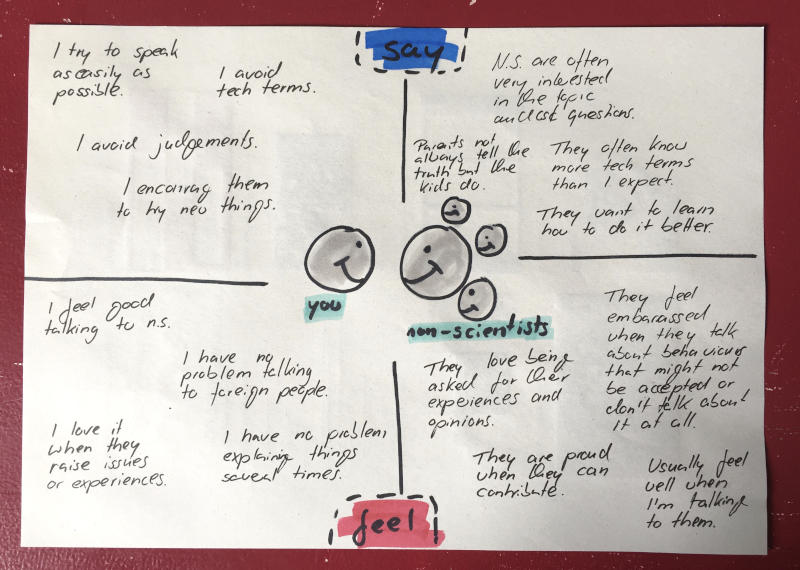Aims of the activity and description of target group
In this activity, you will come into direct contact with people outside your research team or organization. This prepares you for working with volunteers and you analyze which communication skills are needed where in the project.
Resources, Materials needed
Paper, pen, color pencils
Duration
60 minutes
Step 1 – Interview 3 people (should be done before the activity)
If you have never talked to people outside your research area about your research, find at least 3 people and talk to them for 5-10 minutes about your work. Tell them about your Citizen Science project idea and try out how it feels to talk about it. Good opportunities are places where people are waiting, such as bus stops or train stations, cafeterias, stores or your family, friends and neighbors.
Try different approaches for starting the conversation:
- "Excuse me, may I ask you a question? I work in the field of family research and we are working on a new topic. We would like to involve families in this project, but we are not sure if they would be interested."
- "Hi, I'm doing research for a new project where we want to involve people outside the university. Have you had any experience with a research project or would you be interested in participating?"
- "Hi, I am a biologist and I would like to start a project in which citizens participate in counting butterflies in their neighborhood. Could you imagine taking part in such a project?"
Be prepared for people to be skeptical and assume that you are trying to sell them something or have other questionable intentions. So don't be irritated if people give you a skeptical look.
It is easier to start a conversation if you have something to show, e.g. a picture of your research topic or a sketch of the project idea. Also be prepared for people to like your idea and want to know more about the project. Give them your contact details or a link to your organization's website.
Step 2 – Evaluate your experience (25 minutes)
Take a sheet of paper. Place a label or image of yourself and the non-scientists in the middle. Label the top half with "say" and the bottom half with "feel". Divide the paper into 4 sections.

Think of the situations where you have talked to non-scientists about your research topic and write in each section what you or the non-scientists said or felt (or what you impression was they felt).

Take some time to reflect either on your own or in the group on the following questions:
- What worked well for me in the interview?
- What could I do better next time?
- How did the introduction effect the interview? Which option worked best?
- Was my introduction clear enough so people could understand my project idea?
- Which wording did they use in their answers?
- Did I manage to create a positive atmosphere?
Step 3 – Analyze communication tasks in the project (15 minutes)
Take a sheet of paper and give it the heading "Communication in our project". Draw two columns and write two labels "Me" and "Others" at the top of the right-hand column.

In the left-hand column, list the communication tasks that are likely to arise in your project, e.g. communication with volunteers or stakeholders, dissemination, project information,... In the right-hand column, mark which tasks you can or want to do yourself and which tasks should be done by someone else.

This list will help you to put together a team later on. It will also give you an orientation in case you want to develop your communication skills in certain areas, e.g. moderation, presentation or conflict management.
Step 4 – Evaluate communication training options (20 minutes)
Research whether your organization offers communication training or whether you can find training on the Internet. You can also contact a person with good communication skills and ask them for their tips on how to approach communication tasks.
Learning Outcomes - which skills are addressed?
All participants made first experiences talking to people outside their research institute or organization. They reflected their own communication skills and how they feel in situations where they talk to non-scientists or strangers. They evaluated training options.
How do you check the outcomes are reached?
Participants can reflect on their experiences when talking to non-scientists about their work. The participants drew up a list of communication tasks in their project and decided whether they wanted to do them themselves, receive training or pass the task on to someone else.
De-Briefing questions
- How would you describe your experience talking to non-scientists about your project?
- Are there any communication skills you want to develop further?
Further links and readings
- Hua, C. (2022): 5 Tips on Communicating Your Research Effectively. https://gsrc.ucr.edu/blog/2022/11/30/5-tips-communicating-your-research-effectively (last viewed 03/07/2024)
- Morrison, S. (2022): Tips for communicating about your research with non-scientists. https://www.nia.nih.gov/research/blog/2022/11/tips-communicating-about-your-research-non-scientists (last viewed 03/07/2024)
- Roche, J. et al. (2023): Bridging citizen science and science communication: insights from a global study of science communicators. https://www.frontiersin.org/articles/10.3389/fenvs.2023.1259422/full (last viewed 03/07/2024)
- Veeckman, C. et al. (2019): Communication in Citizen Science. A practical guide to communication and engagement in citizen science https://www.scivil.be/sites/default/files/paragraph/files/2020-01/Scivil%20Communication%20Guide.pdf (last viewed 03/07/2024)
